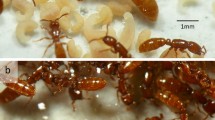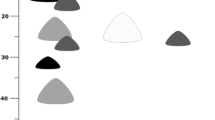Summary
Colonial growth and development of a bamboo carpenter antCamponotus kiusiuensis was studied both by cultivation in the laboratory and by regular sampling in bamboo thickets. The mean mortality of immatures was 44.9±SD 7.5% during claustral colony foundation by a queen: 25.3±8.1% in eggs, 19.4±9.9% in larvae, 3.9±6.3% in prepupae and 4.2±5.6% in pupae. Although the first workers were monomorphic, polymorphism was developed by an increase in larger workers with the growth of colony, achieving the full variation of worker size at population level of about 100 adults. Well-developed colonies were monogynous and polydomous. Queenless satellite nests were most abundant in the autumn to winter, unlike hitherto studied polydomous ants which usually show the peak of nest density in the summer, suggesting that the dead bamboos limited nest space. The scale of polydomy was remarkably dependent on the population size of the colony. Although the alates were more abundant in queenless nests than in queenright nests, the negative effect of queens on the production was not so strong as in the species hitherto reported.
Resume
La croissance et le développement des colonies de la fourmi «charpentière du bambou».Camponotus kiusiuensis ont été étudiés par élevage en laboratoire et par échantillonage régulier dans les forêts de bambous. La mortalité moyenne sur l'ensemble des formes immatures a été de 44,9±SD 7,5% pendant la fondation claustrale de la colonie par la reine: 25,3±8,1% parmi les œufs, 14,1±7,8% parmi les larves, 3.9±6.3% parmi les prénymphes et 4.2±5.6% parmi les nymphes. Si le monorphisme est de règle chez les premières ouvrières, le polymorphisme devient plus marqué parallèlement à la croissance de la colonie et à l'augmentation du nombre de grandes ouvrières jusqu'à ce que l'on atteigne la distribution typique des colonies adultes à partir d'une population de 100 adultes. Les colonies bien développées sont monogynes et polycaliques. Les nids satellites sans femelle sont plus abondants en automne qu'en hiver, contrairement aux nids polycaliques étudiés antérieurement montrant habituellement une augmentation de la densité en nids durant l'été. Ceci suggère que les bambous morts offrent un espace limite de nidification et que le polycalisme est remarquablement dépendant de la taille de population des colonies. Bien que les fourmis ailées soient plus abondantes dans les nids sans reines que dans les nids avec reines, l'effet négatif de la reine sur la production des sexués ne semble pas aussi fort que pour les espèces étudiées auparavant.
Similar content being viewed by others
References
Autuori M., 1956. — La fondation des sociétés chez les fourmis champignonnistes du genre«Atta» (Hym. Formicidae). In: Autuori M., et al., eds.,L'instinct dans le comportement des animaux et de l'homme. pp. 77–104, Masson, Paris.
Brian M.V., 1951. — Summer population changes in colonies of the antMyrmica.Physiol. Comp. Oecol., 2, 248–262.
Brian M.V., 1957. — The growth and development of colonies the antMyrmica.Insectes Soc., 4, 177–190.
Brian M.V., 1979. — Caste differentiation and division of labour. In: Hermann H. ed.,Social Insects, I, pp. 121–222. Academic Press, New York.
Delage-Darchen B., 1974. — Ecologie et biologie deCrematogaster impressa Emery, Fourmi savanicole d'Afrique.Insectes Soc., 21, 13–34.
Eibl-Eibesfeldt I., Eibl-Eibesfeldt E., 1967. — Das Parasitenabwehren der Minima-Arbeiterinnen der Blattschneider-Ameise (Atta cephalotes).Z. Tierpsychol., 24, 278–281.
Gray B., 1971. — A morphometric study of the ant species,Myrmecia dispar (Clark) (Hymenoptera: Formicidae).Insectes Soc., 18, 95–110.
Herbers J.M., 1979. — Caste-biased polyethism in a mound-building ant species.Am. Mid. Nat., 101, 69–75.
Herbers J.M., 1985. — Seasonal structuring of a north temperate ant community.Insectes Soc., 32, 224–240.
Higashi S., 1974. — Worker polyethism related with body size in a polydomous red wood ant,Formica (Formica) yessensis Forel.J. Fac. Sci. Hokkaido Univ., Ser VI, Zool., 19, 695–705.
Higashi S., 1976. — Nest proliferation by budding and nest growth pattern inFormico (Formica) yessensis in Ishikari Shore.J. Fac. Sci. Hokkaido Univ., Ser. VI. Zool., 20, 359–389.
Ichinose K., 1986. — Occurence of polydomy in a monogynous ant,Paratrechina flavipes (Hymenoptera, Formicidae).Kontyu, Tokyo, 54, 208–217.
Ichinose K., 1987. — Seasonal changes in nest and colony densities of the Formicine ant,Paratrechina flavipes (Hymenoptera, Formicidae), in Tomakomai, Southern Hokkaido.Kontyu, Tokyo, 55, 566–572.
Imamura S., 1974. — Observations on the hibernation of a polydomous ant,Formica (Formica) yessensis Forel.J. Fac. Sci. Hokkaido Univ., Ser. VI Zool., 19, 438–444.
Ledoux A., 1950. — Recherche sur la biologie de la fourmi fileuse (Oecophylla longinoda Latr.).Ann. Sci. Nat., Zool. Biol. Anim., 12, 313–461.
Leutert W., 1962. — Beitrag zur kenntnis des Polymorphismus beiCamponotus ligniperda Latr.Mitt. Schweiz. Entomol. Gesellsch, 35, 146–154.
Markin G.P., Diller J.H., Collins H.L., 1973. — Growth and development of colonies of the red imported fire ant,Solenopsis invicta.Ann. Entomol. Soc. Am., 66, 803–808.
Mirenda J.T., Vinson S.B., 1981. — Division of labour and specification of castes in the red imported fire antSolenopsis invicta Buren.Anim. Behav., 29, 410–420.
Mizutani A., Imamura S., 1980. — Population and nest structure in the antAphaenogaster japonica Forel, in Sapporo, Japan.Kontyu, Tokyo, 48, 241–247.
Sanders C.J., 1964. — The Biology of carpenter ants in New Brunswick.Can. Ent., 96, 894–909.
Scherba G., 1958. — Reproduction, nest orientation and population structure of an aggregation of mound nests ofFormica ulkei Emery.Insectes Soc., 5, 201–213.
Scherba G., 1961. — Nest structure and reproduction in the mound building antFormica opaciventris Emery in Wyoming.J. N. Y. Ent. Soc., 69, 71–87.
Torrossian C., 1960. — La biologie de la fourmiDolichoderus quadripunctatus (Hymenoptera-Formicidea-Dolichoderidae).Insectes Soc., 7, 383–393.
Walker J., Stamps J., 1986. — A test of optimal caste ratio theory using the antCamponotus (Colobopsis) impressus.Ecology, 67, 1052–1062.
Weber N.A., 1967. — Growth of youngAcromyrmex colonies in their first year (Hymenoptera: Formicidae).Ann. Entomol. Soc. Am., 60, 506–508.
Weber N.A., 1976. — A ten-year colony ofSericomyrmex urichi (Hymenoptera: Formicidae).Ann. Entomol. Soc. Am., 69, 815–819.
Wilson E.O., 1971. — “The Insect Societies”. Harvard Univ. Press. Cambridge, Mass. 548 p.
Wilson E.O., 1974. — The population consequences of polygyny in the antLeptothorax curvispinosus.Ann. Entomol. Soc. Am., 67, 781–786.
Wilson E.O., 1980. — Caste and division of labor in leaf-cutter ants (Hymenoptera: Formicidae:Atta). I. The overall pattern inA. sexdens.Behav. Ecol. Sociobiol., 7, 143–156.
Wilson E.O., 1983. — Caste and division of labor in leaf-cutter ants (Hymenoptera: Formicidae:Atta). IV. Colony ontogeny ofA. cephalotes.Behav. Ecol. Sociobiol., 14, 55–60.
Wood L.A., Tschinkel W.R., 1981. — Quantification and modification of worker size variation in the fire antSolenopsis invicta.Insectes Soc., 28, 117–128.
Yasumatsu K., 1965. — Formicidae. In: Asahina S., et al., eds.,Iconographia Insectorum Japonicorum Colore naturalei edita, pp. 285–286. Hokuryukan, Tokyo.
Author information
Authors and Affiliations
Rights and permissions
About this article
Cite this article
Ito, F., Higashi, S. & Maeta, Y. Growth and development ofCamponotus (Paramyrmamblys) kiusiuensis Santschi colonies (Hym. Formicidae). Ins. Soc 35, 251–261 (1988). https://doi.org/10.1007/BF02224058
Received:
Accepted:
Issue Date:
DOI: https://doi.org/10.1007/BF02224058




